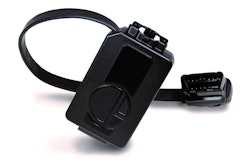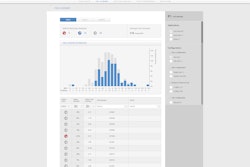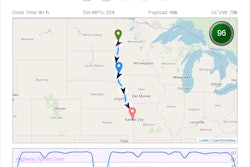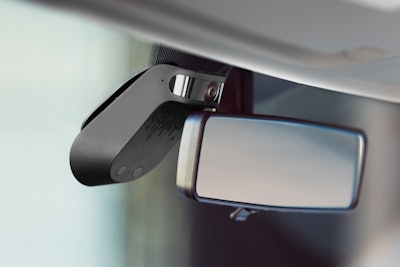 Nauto Prevent uses an inward-facing camera and algorithms to identify distracted driving behaviors while a vehicle is moving.
Nauto Prevent uses an inward-facing camera and algorithms to identify distracted driving behaviors while a vehicle is moving.Driver distraction and speed are major crash risks, but with today's technology, fleets can mitigate accidents related to those factors.
While telematics systems connected to vehicle ECUs and sensors can identify these and other symptoms of risky driving behaviors from event data after the fact, vision-based safety systems can alert drivers in real time with instant feedback and coaching to ultimately change those behaviors.
Nudging versus nagging
Several companies have vision-based safety systems that identify risk by combining event data with live video from inward and outward-facing cameras. The systems use algorithms that find patterns in complex data sets.
Exactly how these safety technologies should interact with drivers in a live environment is a matter of debate. Could giving drivers visual or audible alerts cause more problems than they prevent?
[RELATED: AI accuracy is critical in avoiding false alerts and alert fatigue]
The SmartDrive vision-based safety platform has a network device that connects with cameras, electronic control units (ECUs), sensors and various OEM and third-party advanced driver assistance systems (ADAS) in vehicles.
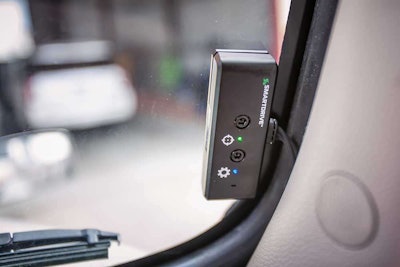 A sensor bar for SmartDrive’s SR4 platform has indicator lights that fleets can use to alert drivers to risky behaviors.
A sensor bar for SmartDrive’s SR4 platform has indicator lights that fleets can use to alert drivers to risky behaviors.The software algorithms onboard the device instantly detect patterns of risky behaviors known as trigger events. The events trigger the capture of video and event data for review by SmartDrive’s managed service.
The company has a line of SmartSense products that use machine vision to detect complex behaviors in real time. One product monitors eye movements and head positions of drivers to detect inattention, distraction and drowsy driving behaviors.
For these and other types of risky behaviors, SmartDrive has customers who opt to give drivers real-time feedback using green, yellow and red-light notifications on the camera.
“It’s important to strike a balance between the value of alerting drivers immediately and what can be addressed later so as not to overwhelm them,” said Jason Palmer, vice president of global product strategy at Solera Holdings, parent company of Omnitracs, which acquired SmartDrive in 2020.
Samsara offers a dash camera as part of a fleet management and data platform that combines real-time GPS tracking, electronic logs, wireless sensors, video and mobile applications. The platform is used by more than 5,000 fleets.
It coaches drivers in the moment related to things like harsh braking or speed threshold using tone alerts that capture their attention. The system’s camera vision technology can detect distracted driving and tailgating events by analyzing a driver's gaze, following distance and nearby objects.
‘You are distracted’
Nauto’s dual-camera computer vision system, Nauto Coach, uses a device that mounts near the rearview mirror that captures and transmits video and data of risky driving events to a web portal for review by fleet management.
Nauto Prevent is an optional product for Nauto Coach that uses the inward-facing camera and algorithms to identify distracted driving behaviors while a vehicle is moving.
The web portal shows risk profiles of drivers based on Nauto’s Visually Enhanced Risk Assessment (VERA) scoring method that focuses on attentive driving, speeding and smooth driving (accelerometer). Attentiveness is the most heavily weighted factor, with Nauto analysis showing distraction is a factor in 70% of collisions.
Algorithms of Nauto Prevent monitor a driver’s head, eyes and torso to determine if eyes are on the road.
Drivers get progressive in-cab alerts if they are distracted while a vehicle is moving. A driver is not alerted for looking at a cell phone at a stoplight, for instance. The severity of risk is based on the length of time a driver is not looking at the road and the speed of the vehicle.
Drivers hear a beep at the first sign of distraction. If they continue the behavior, the device will say “distracted.” After four seconds, the tone becomes more severe to command their attention.
Maintaining trust
Companies that develop vision-based safety systems say that alerting drivers to risks in their environment is counterproductive unless drivers trust the accuracy of the alerts.
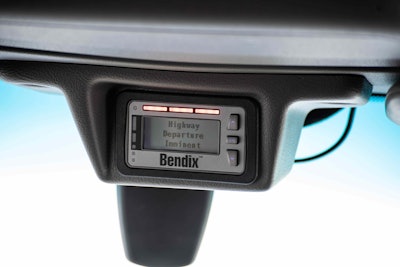 Bendix Wingman Fusion combines radar and camera inputs to warn drivers of collision risks.
Bendix Wingman Fusion combines radar and camera inputs to warn drivers of collision risks.Nauto has tuned its algorithms to limit “false positives” for distracted driving to build trust. Limiting false positives has tradeoffs because the system may bypass distracted behaviors that are not as obvious in order to maintain that trust.
A vision-based system needs to incorporate multiple sensors to have an effective algorithm and prevent false positives, Palmer said.
“When testing SmartSense against standalone solutions, we found that if a driver is going around a curve, he or she is looking at the curve and not straight ahead,” he said. “A dual camera configuration is necessary to show that the lines in the road are paired to the driver’s eyes and eliminate the false positive that another system is measuring.”
The Bendix Wingman Fusion system adds a camera to work with the radar of Wingman Advanced for collision mitigation. The combo delivers more information to the system, which enables an earlier read on situations to have fewer false alerts and false interventions.
For instance, the camera helps the radar determine if the object ahead is a stalled vehicle in the lane of travel, said Fred Andersky, director of demos, sales and service training at Bendix Commercial Vehicle Systems.
The Bendix safety systems can be adjusted to fit a fleet or owner-operator’s needs for specific alert strategies. Some want a more conservative approach with following distance alerts at three seconds, two seconds and one second at highway speeds. Others may want a more aggressive approach, he said.
Bendix offers a Web portal called SafetyDirect that provides fleet operators with videos of severe events along with feedback on fleet and driver performance. The system wirelessly transmits real-time video data and event-based information for analysis by fleet safety personnel.
Samsara automatically records harsh events for review by driver managers through a web-based portal. The video events are made available in near real time in the Safety Inbox feature, tagged with labels for the risky behavior detected.
Fleets can change the automatic labels on the videos if necessary. When tags are changed it provides instant feedback to Samsara, which further improves the accuracy of the camera vision technology to detect risk.
Self-coaching tools
In addition to giving drivers real-time feedback, fleets are using technologies that let drivers coach themselves. The self-coaching strategy is most applicable for safety infractions that fleets believe drivers can correct simply by being aware of the problem.
 Fleets that use the DriveCam program can have certain event videos sent to drivers automatically to review in a responsive web application.
Fleets that use the DriveCam program can have certain event videos sent to drivers automatically to review in a responsive web application.Lytx offers a managed service, DriveCam, that includes review of event video by Lytx analysts who observe for driver behaviors such as distraction.
Drivers are also alerted to risky behaviors in the cab. The ActiveVision platform from Lytx gives real-time feedback to drivers while capturing video of risky events for review through the DriveCam program.
ActiveVision monitors lane markings and surrounding vehicles to identify certain patterns of risk and issues real-time audible alerts for distracted and fatigued driving. One of the audible alerts is a rumble strip sound for patterns indicative of distracted or fatigued driving such as unintentional lane departures.
For short following distances ActiveVision gives a sequence of beeping noises, said Kristin Costas, senior director of product management for Lytx.
Fleets that use the DriveCam program can have certain event videos sent automatically to drivers to review through a responsive web application. Drivers login and review curated event records and a 90-day score.
The types of behaviors fleets typically assign for self-coaching are more frequent and lower risk such as not using a seatbelt or close following distances, Costas said. As a standard, DriveCam gives drivers four days to coach themselves before an event is flagged as overdue.
SmartDrive has an app that drivers can use to retrieve performance scores, video and any safety observations. The app gives drivers the ability to self-evaluate, manage bad habits and work to improve skills with greater visibility into their progress.
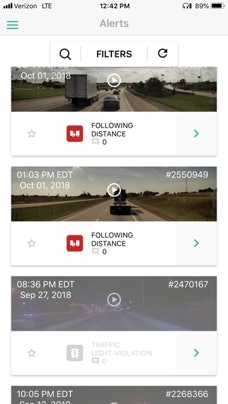 The Driveri Mobile Coach app from Netradyne gives drivers videos of recorded events for training.
The Driveri Mobile Coach app from Netradyne gives drivers videos of recorded events for training.“When management and drivers are equally engaged in identifying strengths and weaknesses, while acknowledging improvement, self-coaching begins to operate as a supporting asset to the training programs the company has in place,” Palmer said.
Bendix developed a phone application that allows for information from its SafetyDirect portal to be downloaded directly to a phone to get information quickly to fleet managers and drivers.
Through the same mobile application that Samsara uses for its ELD application, drivers can view a safety scorecard that updates weekly to see where they rank against their peers in a leaderboard. Drivers can also login to a separate Driver Safety portal to obtain more granular feedback and see the locations where they had harsh events.
Samsara has chosen not to include video records in the Driver Safety portal to protect the privacy of drivers and fleets by preventing the unauthorized use or distribution of video event records.
Automated training
Coaching and training drivers based on video and event records can be difficult, especially if drivers are on the road for days and even weeks at a time.
New developments can lighten the burden of fleet managers by giving drivers immediate notifications and reminders before the events are recorded and sent to their fleets for review.
Netradyne has developed a suite of in-cab alerts for its Driveri (“driver eye”) vision system for following distance, speeding, rolling stops and yawning as an early sign of fatigue. The system can also alert for distraction by monitoring drivers’ eye and head movements, said Adam Kahn, chief business development officer at Netradyne.
Netradyne is currently working with early adopter customers to have the real-time alerts activated on their units before finalizing the products for broader commercial release.
“We spent a lot of time ensuring the precision and accuracy is super high,” Kahn said.
Its fleet customers can use the Driveri Mobile Coach app, which gives drivers their current “GreenZone” safety score at the end of each trip. With the app, drivers can review videos of recorded events for training, which are selected and curated by fleet managers.
The app also shows drivers what behaviors they can change, such as speeding, to increase their scores, Kahn said.
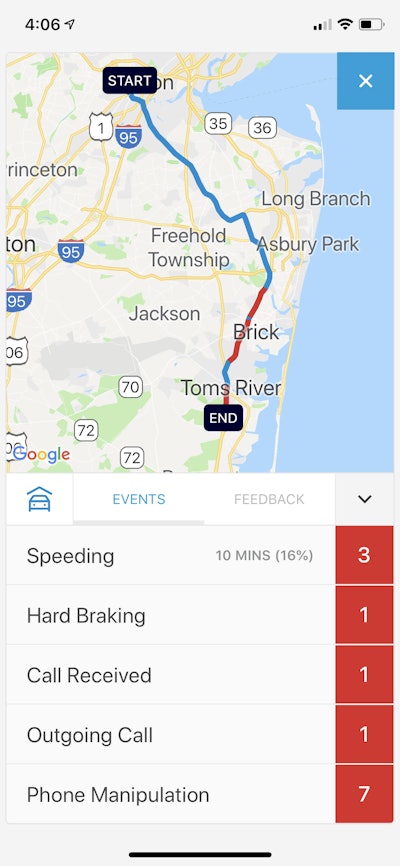 The Mentor app from eDriving gives drivers a heat map that shows where their risky events occurred.
The Mentor app from eDriving gives drivers a heat map that shows where their risky events occurred.eDriving, which was also acquired by Solera, has a smartphone and telematics software-as-a-service platform called Mentor that fleets can use as part of a closed-loop risk management program that includes online driver training courses.
The Mentor app runs on smartphones or tablets and tracks driver behaviors for acceleration, braking, speeding and distraction by detecting if drivers pick up their phones while driving.
The app gives an audible alert to drivers when they exceed a maximum speed setting.
When not in motion, drivers can use the app to view their scores. A first-level summary shows the number of risk events for each category. Clicking on summary data opens a heat map that shows where the events occurred.
Driver managers cannot view the event map. This approach ensures drivers have privacy of their own information, said Ed Dubens, CEO of eDriving. Managers can view the number of risk events for each driver and their Mentor scores for coaching the most at-risk drivers in the fleet.
Mentor has an integration with ELD and telematics platform Geotab and with Nauto to use additional data captured by these systems for scoring driver risk, Dubens said.
Mentor’s online training modules are delivered through the app. Typically, fleets assign all drivers in the fleet quarterly training that takes 20 to 30 minutes to complete. High-risk drivers can be automatically assigned weekly courses based on specific behaviors that take three to five minutes to complete.
Assisting with autonomy
Autonomous trucks are on the horizon as vehicle safety systems continue to advance. Machine vision technology will continue to play an active role in monitoring the environment to ensure drivers are ready to take control at a moment’s notice, Palmer said.
“The backup driver for an autonomous vehicle must be as attentive as if they were behind the wheel of a non-autonomous vehicle,” he said.
Fleet managers will have information to understand how and why the driver got into a situation where a vehicle’s braking and steering systems had to take control to prevent collisions, for example.
“Our job is to deliver the technology that guarantees drivers are using newer technologies in a safer manner as we progress up the ladder to full autonomy,” Palmer said.



